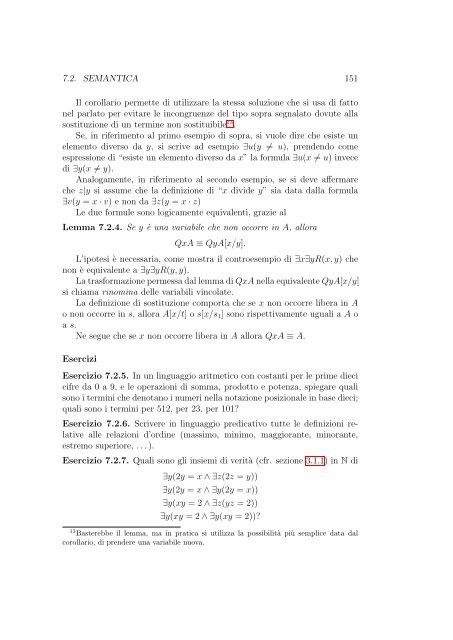Logica Matematica Corso di Laurea in Informatica ... - Mbox.dmi.unict.it
Logica Matematica Corso di Laurea in Informatica ... - Mbox.dmi.unict.it
Logica Matematica Corso di Laurea in Informatica ... - Mbox.dmi.unict.it
Create successful ePaper yourself
Turn your PDF publications into a flip-book with our unique Google optimized e-Paper software.
7.2. SEMANTICA 151<br />
Il corollario permette <strong>di</strong> utilizzare la stessa soluzione che si usa <strong>di</strong> fatto<br />
nel parlato per ev<strong>it</strong>are le <strong>in</strong>congruenze del tipo sopra segnalato dovute alla<br />
sost<strong>it</strong>uzione <strong>di</strong> un term<strong>in</strong>e non sost<strong>it</strong>uibile 13 .<br />
Se, <strong>in</strong> riferimento al primo esempio <strong>di</strong> sopra, si vuole <strong>di</strong>re che esiste un<br />
elemento <strong>di</strong>verso da y, si scrive ad esempio ∃u(y = u), prendendo come<br />
espressione <strong>di</strong> “esiste un elemento <strong>di</strong>verso da x” la formula ∃u(x = u) <strong>in</strong>vece<br />
<strong>di</strong> ∃y(x = y).<br />
Analogamente, <strong>in</strong> riferimento al secondo esempio, se si deve affermare<br />
che z|y si assume che la def<strong>in</strong>izione <strong>di</strong> “x <strong>di</strong>vide y” sia data dalla formula<br />
∃v(y = x · v) e non da ∃z(y = x · z)<br />
Le due formule sono logicamente equivalenti, grazie al<br />
Lemma 7.2.4. Se y è una variabile che non occorre <strong>in</strong> A, allora<br />
QxA ≡ QyA[x/y].<br />
L’ipotesi è necessaria, come mostra il controesempio <strong>di</strong> ∃x∃yR(x, y) che<br />
non è equivalente a ∃y∃yR(y, y).<br />
La trasformazione permessa dal lemma <strong>di</strong> QxA nella equivalente QyA[x/y]<br />
si chiama r<strong>in</strong>om<strong>in</strong>a delle variabili v<strong>in</strong>colate.<br />
La def<strong>in</strong>izione <strong>di</strong> sost<strong>it</strong>uzione comporta che se x non occorre libera <strong>in</strong> A<br />
o non occorre <strong>in</strong> s, allora A[x/t] o s[x/s1] sono rispettivamente uguali a A o<br />
a s.<br />
Ne segue che se x non occorre libera <strong>in</strong> A allora QxA ≡ A.<br />
Esercizi<br />
Esercizio 7.2.5. In un l<strong>in</strong>guaggio ar<strong>it</strong>metico con costanti per le prime <strong>di</strong>eci<br />
cifre da 0 a 9, e le operazioni <strong>di</strong> somma, prodotto e potenza, spiegare quali<br />
sono i term<strong>in</strong>i che denotano i numeri nella notazione posizionale <strong>in</strong> base <strong>di</strong>eci;<br />
quali sono i term<strong>in</strong>i per 512, per 23, per 101?<br />
Esercizio 7.2.6. Scrivere <strong>in</strong> l<strong>in</strong>guaggio pre<strong>di</strong>cativo tutte le def<strong>in</strong>izioni relative<br />
alle relazioni d’or<strong>di</strong>ne (massimo, m<strong>in</strong>imo, maggiorante, m<strong>in</strong>orante,<br />
estremo superiore, . . . ).<br />
Esercizio 7.2.7. Quali sono gli <strong>in</strong>siemi <strong>di</strong> ver<strong>it</strong>à (cfr. sezione 3.1.1) <strong>in</strong> N <strong>di</strong><br />
∃y(2y = x ∧ ∃z(2z = y))<br />
∃y(2y = x ∧ ∃y(2y = x))<br />
∃y(xy = 2 ∧ ∃z(yz = 2))<br />
∃y(xy = 2 ∧ ∃y(xy = 2))?<br />
13 Basterebbe il lemma, ma <strong>in</strong> pratica si utilizza la possibil<strong>it</strong>à più semplice data dal<br />
corollario, <strong>di</strong> prendere una variabile nuova.




![Introduzione ai sistemi Wiki [PDF] - Mbox.dmi.unict.it](https://img.yumpu.com/16413205/1/184x260/introduzione-ai-sistemi-wiki-pdf-mboxdmiunictit.jpg?quality=85)











